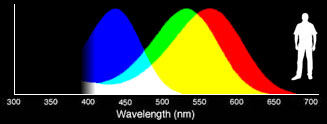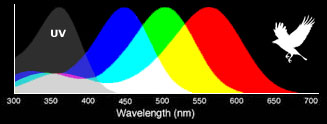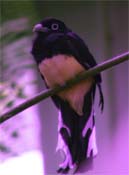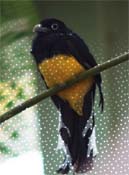
![]()
![]()
Ultraviolet
Bird Photography
by Nathan Chronister
Birds can see ultraviolet light, which is invisible to the human eye. In addition to ultraviolet, birds can also see all the colors that we can see. This raises the question, what do birds look like, to other birds?
To answer this question, I spent one year building a special camera system that can photograph birds in all the colors of visible light, plus ultraviolet, at the same time.
| On some web sites, you can find supposed examples of "bird vision", which are completely fabricated. It's good, they are at least teaching the concept that birds can see colors that humans can't see. But I wanted to produce images that actually correspond to what is captured by a bird's eye. It turns out this picture of a rainbow-colored common hill mynah is pretty far off. |  |
Typical cameras can
sense red, green, and blue light. Every color in a photo is made up of
some combination of these three "primary" colors. For example,
yellow is a combination of red and green. White is a combination of red,
green, and blue. This "RGB" color system mimics the human eye.
We have special cells in the retina of the eye, called "cones",
which detect red, green, or blue light. Since the camera works like the
human eye, it can capture every color that the human eye can see. You
can adjust the sliders below, to see how any color can be made through
various combinations of red, green, and blue.
Since every color is a combination of three components, color is said to have three dimensions. By adding the ultraviolet sensor, we create a four-color or tetrachromatic imaging system. This mimics the function of the bird's eye, which can perceive ultraviolet light, as well as red, green, and blue.
Color Perception in Humans and Birds
Each type of cone can actually detect light over a broad range of wavelengths. The sensitivities overlap so that a pure yellow light of 550 nm will activate both the red and the green cone cells of the retina (but the light reflected from objects is usually a mix of wavelengths). The diagram below shows the wavelength senstivities of the three types of cones in the human eye.
 |
Wavelength sensitivities of the blue, green, and red cones in the human eye. |
Birds have the same three types of cones in the retina. But they also have a fourth type, which detects ultraviolet light. (In some birds, the fourth cone detects violet instead.) For birds, color has four dimensions. They can see a multitude of different colors that we humans cannot see or even imagine. One of the challenges of my work has been to present the images in a way that captures this fourth dimension of avian color perception.
 |
Wavelength sensitivities of the four types of cones in the eye of a bird. |
How to Show Four Dimensions of Color
Originally, I planned to present the images in the form of a stereogram. Your right eye could view the normal, visible light image, and your left eye could view the ultraviolet image, at the same time. In this way, I thought, the human eyes should be able to see the four-dimensional color that birds can perceive. Unfortunately, as I learned, it is not possible to train the eyes to interpret the dual images as four dimensions of color. Instead, our eyes will strain to derive some depth perception from the left and right images. But you can study the two images, side-by-side, and observe which parts of the bird are reflecting the most ultraviolet light.

The next method is to compress the broad spectrum of colors, perceived by birds, into the narrower spectrum perceived by the human eye. In this method, we actually lose the four-dimensional aspect of bird vision. The full richness of our visible light colors is given up, in order to accommodate the ultraviolet. But at least, we are able to produce a single image that includes the ultraviolet reflectance.
The diagram below shows how the four RGBU color channels are merged together to produce three RGB color channels. The original red and green color channels are combined to make a new red channel. The original green and blue channels are combined to make the new green channel. The ultraviolet channel is copied directly to the blue channel of the new image.
The result is that any ultraviolet-colored areas will appear blue, and all the other colors are shifted a bit. Blue becomes green, green becomes yellow/brown, and red stays red. The nice thing is, the colors still correspond to wavelength. That's like normal human vision except now we are including the ultraviolet.
The flower in this example appears purple, because it reflects both ultraviolet and red light. Red and blue makes purple. You will see this again when you look at the photos of birds.
|
Another method is to overlay a purple color onto the image to represent ultraviolet. This method has been used before. It's possible to produce some neat effects this way, but it's misleading as to what birds actually see. For one thing,
this type of overlay obscures the original colors of the image.
The example here shows a green-backed trogon at the Buffalo Zoo.
Can you tell that the bird has a yellow breast that also reflects
ultraviolet? Or is the breast simply a salmon pink color? |
 |
|
|
Finally, I devised a way to show the four dimensions of bird coloration. We can only see three dimensions of color, but our eyes can perceive a fourth dimension, which is texture. By overlaying a textured pattern onto the image, I was able to show the fourth dimension, the ultraviolet light. This is done without affecting the visible colors that we know and love. Here is an example of the textured, four-dimensional image. The white dot pattern occurs wherever there is ultraviolet light. Now you can clearly see that the breast of the bird is reflecting ultraviolet and yellow light. |
 |
For the various image galleries on this web site, I will be using several of the methods shown above, depending on what I feel works best in the particular situation. If you have any questions or would like to reproduce any of the images, for example on your web site, please send email to .
Ultraviolet Photo Galleries
Study
Skins Collection - A broad survey of ultraviolet coloration using
preserved specimens from a wide range of species.
Backyard
Birds - Ultraviolet photos of some of the common feeder birds in the
eastern United States.
Aviary
Species - Some colorful bird species from all over the world.
The Birds' Environment - Birds may use their ultraviolet vision to look for food. Here are some plants and features of the environment photographed in ultraviolet.